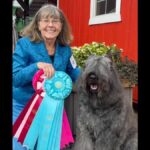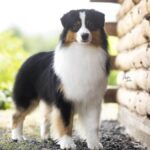This article was originally published in Showsight Magazine, July 2013 issue.
Judging the Scottish Terrier
The silhouette of the Scottish Terrier is one of the most recognizable in dogdom. As a judge we go well beyond and are able to recognize, compare and contrast specimens according to the salient features and disposition of the breed. Judging my breed is a special delight and experience. No matter the weather, time of day or state of exhaustion when the Scots enter the ring I am excited to view the dogs. An important criterion in judging is a deep understanding and appreciation of the unique structure and temperament that makes the Scottish Terrier. This is a breed with a purpose, small, sturdy and fearless in going to earth after badger and other prey. Scottish Terriers enter the ring with confidence owning the ground they stand upon. Many are busybodies and often resist their handler’s efforts to set them up and even face in the proper direction.
They are independent and self-assured and are certain that they are the best regardless of your judgment. Often they will verbalize that belief, and your ring may not be a quiet one. I assess the dogs initially looking for the essentials that are in the first paragraph of our standard. In general appearance this is a compact, muscular dog of good bone and substance with a head that is long in proportion to its size. I look for a smooth flow of neck into shoulder, level topline, a definite pronounced forechest and rump extending beyond the tail. The tail is NOT the end of a Scottish Terrier. A preliminary examination is made of the dogs from the front and top to check proper expression and width of the dog. I never bring a Scottie directly to the table. This is a busy breed. It is useful to let the breed (even single entry classes) gait around before examination allowing them to peruse the area and calm themselves. This is a breed that is groomed, stripped, conditioned and generally well presented.
The exhibitors have usually spent numerous hours, weeks and months preparing the proper hand-stripped coat for your examination. I am careful that my hands-on examination respects the dog and the time spent. The coat is an important breed feature. It is functional and critical to the dog and related to the climate of the country of origin and the work it needs to accomplish. This is a double-coated breed with a HARD, wiry topcoat covering its dense soft undercoat. As an exhibitor, I learned to groom the dogs and to actually enjoy the hours plucking hair, raking undercoat, brushing, blending and presenting a broken-coated terrier. I check the texture by rubbing the top hair (not fur) just in front of the tail between my thumb and index finger. I pick up the coat and check for the prerequisite, insulating undercoat. I replace any lifted hairs, never rake the coat backwards and even smooth lifted brows. Proper hard coats are relished and rewarded. Skillful grooming enhances this breed and can camouflage problems. The examination on the table and subsequent viewing of the free-standing dog are essential to the proper evaluation of this breed. I stand back and take the few minutes to view the dog on the table both from the side and front of the dog before proceeding with my hands-on examination. I take a minute to observe the expression. The correct expression once seen is hard to forget.
The Scot will look down his big black nose at you with a penetrating gaze letting you know he is in charge. It is described as ‘varminty’ and should NEVER be sweet, appealing or cute. Reaching out, I cup the head underneath the muzzle and feel its strength that fills my hand and the punishing, strong under jaw. The teeth are big and provide the dog with a strong grasp of the badger while the moderately short, strong neck can shake, snap and dispatch its prey. I check for the proper EQUAL proportion of skull to muzzle and check for the slight but definite stop. I feel under the hair to determine that there is true fill below the dark, almond, wide-set eyes. The cheeks are clean, and the ears are small and set up on the head. All together the proper head and expression provide a window into the determined working nature of the breed and can thrill the appreciative judge. The Scottish Terrier is a big dog on short legs. Moving to the side of the dog, I enjoy running my hand smoothly down the strong moderately short neck across the shoulders and body reconfirming a smooth transition into the “well laid back and moderately well knit” shoulders. As a breeder and judge it is critical to check for actual layback of shoulder (not hair) and especially for an upper arm that is approximately the same length as the shoulder blade bringing the elbow next to the body and below the widest point of the rib. The chest is broad and deep. It is heart-shaped (not slab-sided or barrel-shaped) and drops BELOW the elbow. I feel for the forechest (prosternum) that is well in front of the dog and check the depth of brisket from the side of the dog.
As a breed judge, the proper examination of my breed is clear as described in the standard. For example, it states “the lowest point of the brisket should be such that an average man’s fist would fit under it with little or no overhead clearance” therefore, there is an expectation that we check that by actually placing our fist under the dog. What a joy to find this depth of chest. I check the length of rib providing the heart, lung capacity and for the breed’s short strong loin essential to support the topline, strength of spine and turning radius within a badger hole. Moving to the end of the dog, we find this sturdy dog is equally strong and wide in the beam. The tail should never be the end of a Scot. Behind the tail, the point of ischium extends past its set on.
The rear is broad with muscular hindquarter and a well-bent stifle. The length from hock to heel should be short and perpendicular to the ground. This well developed and a correctly structured rear is necessary to the work of the breed as it drives his short, low, powerful body, moves from rock to rock, and pulls the vermin from its den. The tail is accurately described as an inverse carrot. It is properly set on high and carried proudly. I generally prefer the tail be approximately the same height as the top of the head, however, more importantly it is a keen bellwether of the disposition of the dog – carried up is confident and proud; wagging side to side is happy to be here; flicking back and forth a warning to others. The proper structure is assessable on the move. The overly profuse furnishing on some exhibits can make it difficult to assess proper movement. From the rear, the movement should be straight and true with good flex at the hock and the pads of the rear feet should turn up toward you. The legs should be well apart and neither turn in at the foot nor out. With good width, low hock to heel and a well bent stifle this proper movement is more evident. When the dog returns and we view the front movement, the forelegs are not exactly parallel to one another. You will notice a slight turn in as the legs reach out around the deep chest of the dog. From the side the Scottish Terrier should have both reach and drive. With a well laid back shoulder and a good length of upper arm it is capable of reaching out while the powerful rear drives forward. The topline remains level. It is a pleasure to view the level topline as the dog covers ground like it is on skates.
One should never misconstrue lots of quick little steps for the pleasing effective motion of this breed. While the ears may fold back the tail is up. I find it extremely useful, informative and moving to view Scottish Terriers standing on their own rather than being poked and prodded into a predetermined stance. From years as an exhibitor, I have found that some dogs much prefer ‘showing themselves’. When the dogs stand naturally, it both enhances their strengths and shows their weaknesses. That perfectly primped topline sags and slopes; the structurally sound remains steady. The desired pronounced forechest and well developed rear behind the tail is evident. The tail, ears and expression that helps define proper temperament is on exhibit. I do spar the dogs and bitches. I do not need to spar every dog and set very specific guidelines to be followed. Standing on their own, holding ground and on full alert is to view the true dog. It is bold, confident, sturdy, strong and dignified. It moves me and my love of the breed to see the dogs sparred and shown correctly. There is a universal deep breath and “oooh’ from ringside when this is viewed. The adjectives and descriptors of the Scottish Terrier are to be sought and rewarded in judging the breed. It is small, compact, short-legged, sturdy and of good bone and substance. The coat is an essential of the breed being both weather resistant and capable of protection from burrs, bramble and soil. It is double coated with a hard wiry topcoat and soft undercoat. The body is cobby, thick-set and hung between short heavy legs. The Scottish terrier has deep brisket, pronounced forechest and a strong muscular rear.
The expression is keen and varminty. He is bold, confident and dignified. I evaluate as above and prize the characteristics of type that are hard to breed. Obtaining the ear and eye that contributes to the breeds unflinching gaze, achieving the proper front and rear especially the proper length of upper arm and short parallel hock to heel, and the essential coat of almost any color. Most of all the spirit and uniqueness of character that make this a breed that moves me and makes me admire it above all others. Evelyn Kirk put it so very well in her essay on the breed by stating, “His commanding presence, his unflinching gaze, his deep rooted conviction that he is his own man; these are the attributes of the adult Scottish Terrier of proper type. Once witnessed, this attitude is hard to forget.










